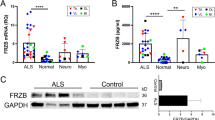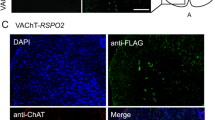Abstract
Wnts are secreted proteins with functions in differentiation, development and cell proliferation. Wnt signaling has also been implicated in neuromuscular junction formation and may function in synaptic plasticity in the adult as well. Secreted frizzled-related proteins (Sfrps) such as Sfrp1 can function as inhibitors of Wnt signaling. In the present study a potential role of Wnt signaling in denervation was examined by comparing the expression levels of Sfrp1 and key proteins in the canonical Wnt pathway, Dishevelled, glycogen synthase kinase 3β and β-catenin, in innervated and denervated rodent skeletal muscle. Sfrp1 mRNA and immunoreactivity were found to be up-regulated in mouse hemidiaphragm muscle following denervation. Immunoreactivity, detected by Western blots, and mRNA, detected by Northern blots, were both expressed in extrasynaptic as well as perisynaptic parts of the denervated muscle. Immunoreactivity on tissue sections was, however, found to be concentrated postsynaptically at neuromuscular junctions. Using β-catenin levels as a readout for canonical Wnt signaling no evidence for decreased canonical Wnt signaling was obtained in denervated muscle. A role for Sfrp1 in denervated muscle, other than interfering with canonical Wnt signaling, is discussed.





Similar content being viewed by others
References
Bafico A, Gazit A, Pramila T, Finch PW, Yaniv A, Aaronson SA (1999) Interaction of frizzled related protein (FRP) with Wnt ligands and the frizzled receptor suggests alternative mechanisms for FRP inhibition of Wnt signaling. J Biol Chem 274:16180–16187
Chen J, Park CS, Tang S-J (2006) Activity-dependent synaptic Wnt release regulates hippocampal long term potentiation. J Biol Chem 281:11910–11916
Ciani L, Salinas PC (2005) Wnts in the vertebrate nervous system: from patterning to neuronal connectivity. Nat Rev Neurosci 6:351–362
Cifuentes-Diaz C, Goudou D, Mège R-M, Velasco E, Nicolet M, Herrenknecht K, Rubin L, Rieger F (1998) Distinct location and prevalence of α-, β-catenins and γ-catenin/plakoglobin in developing and denervated skeletal muscle. Cell Adhes Commun 5:161–176
Ding VW, Chen R-H, McCormick F (2000) Differential regulation of glycogen synthase kinase 3β by insulin and Wnt signaling. J Biol Chem 275:32475–32481
Esteve P, Trousse F, Rodríguez J, Bovolenta P (2003) SFRP1 modulates retina cell differentiation through a β-catenin-independent mechanism. J Cell Sci 116:2471–2481
Fan S, Ramirez SH, Garcia TM, Dewhurst S (2004) Dishevelled promotes neurite outgrowth in neuronal differentiating neuroblastoma 2A cells, via a DIX-domain dependent pathway. Brain Res Mol Brain Res 132:38–50
Fertuck HC, Salpeter MM (1974) Localization of acetylcholine receptor by 125I-labelled α-bungarotoxin binding at mouse motor endplates. Proc Nat Acad Sci USA 71:1376–1378
Finch PW, He X, Kelley MJ, Üren A, Schaudies RP, Popescu NC, Rudikoff S, Aaronson SA, Varmus HE, Rubin JS (1997) Purification and molecular cloning of a secreted, frizzled-related antagonist of Wnt action. Proc Natl Acad Sci 94:6770–6775
González-Sancho JM, Brennan KR, Castelo-Soccio LA, Brown AMC (2004) Wnt proteins induce dishevelled phosphorylation via an LRP5/6-independent mechanism, irrespective of their ability to stabilize β-catenin. Mol Cell Biol 24:4757–4768
Kim C-H, Xiong WC, Mei L (2003) Regulation of MuSK expression by a novel signaling pathway. J Biol Chem 278:38522–38527
Lee J-S, Ishimoto A, Yanagawa S-I (1999) Characterization of mouse dishevelled (Dvl) proteins in Wnt/Wingless signaling pathway. J Biol Chem 274:21464–21470
Levin JM, El Andalousi RA, Dainat J, Reyne Y, Bacou F (2001) SFRP2 expression in rabbit myogenic progenitor cells and in adult skeletal muscles. J Muscle Res Cell Motil 22:361–369
Luo ZG, Wang Q, Zhou JZ, Wang J, Luo Z, Liu M, He X, Wynshaw-Boris A, Xiong WC, Lu B, Mei L (2002) Regulation of AChR clustering by dishevelled interacting with MuSK and PAK1. Neuron 35:489–505
Luo Z, Wang Q, Dobbins GC, Levy S, Xiong WC, Mei L (2003) Signaling complexes for postsynaptic differentiation. J Neurocytol 32:697–708
Magnusson C, Högklint L, Libelius R, Tågerud S (2001) Expression of mRNA for plasminogen activators and protease nexin-1 in innervated and denervated mouse skeletal muscle. J Neurosci Res 66:457–463
Magnusson C, Libelius R, Tågerud S (2003) Nogo (reticulon 4) expression in innervated and denervated mouse skeletal muscle. Mol Cell Neurosci 22:298–307
Magnusson C, Svensson A, Christerson U, Tågerud S (2005) Denervation-induced alterations in gene expression in mouse skeletal muscle. Eur J Neursci 21:577–580
McManus EJ, Sakamoto K, Armit LJ, Ronaldson L, Shpiro N, Marquez R, Alessi DR (2005) Role that phosphorylation of GSK3 plays in insulin and Wnt signalling defined by knockin analysis. EMBO J 24:1571–1583
Melkonyan HS, Chang WC, Shapiro JP, Mahadevappa M, Fitzpatrick PA, Kiefer MC, Tomei LD, Umansky SR (1997) SARPs: a family of secreted apoptosis-related proteins. Proc Natl Acad Sci 94:13636–13641
Packard M, Koo ES, Gorczyca M, Sharpe J, Cumberledge S, Budnik V (2002) The Drosophila Wnt, Wingless, provides an essential signal for pre- and postsynaptic differentiation. Cell 111:319–330
Rattner A, Hsieh J-C, Smallwood PM, Gilbert DJ, Copeland NG, Jenkins NA, Nathans J (1997) A family of secreted proteins contains homology to the cysteine-rich ligand-binding domain of frizzled receptors. Proc Natl Acad Sci 94:2859–2863
Rodriguez J, Esteve P, Weinl C, Ruiz JM, Fermin Y, Trousse F, Dwivedy A, Holt C, Bovolenta P (2005) SFRP1 regulates the growth of retinal ganglion cell axons through the Fz2 receptor. Nat Neurosci 8:1301–1309
Sharma SK, Wallace BG (2003) Lithium inhibits a late step in agrin-induced AChR aggregation. J Neurobiol 54:346–357
Svensson A, Libelius R, Tågerud S (2008) Semaphorin 6C expression in innervated and denervated skeletal muscle. J Mol Histol 39:5–13
Tang S-J (2007) The synaptic Wnt signaling hypothesis. Synapse 61:866–868
Wang QM, Fiol CJ, DePaoli-Roach AA, Roach PJ (1994) Glycogen synthase kinase-3β is a dual specificity kinase differentially regulated by tyrosine and serine/threonine phosphorylation. J Biol Chem 269:14566–14574
Wang J, Jing Z, Zhang L, Zhou G, Braun J, Yao Y, Wang Z-Z (2003) Regulation of acetylcholine receptor clustering by the tumor suppressor APC. Nat Neurosci 6:1017–1018
Witzemann V (2006) Development of the neuromuscular junction. Cell Tissue Res 326:263–271
Wodarz A, Nusse R (1998) Mechanisms of Wnt signaling in development. Annu Rev Cell Dev Biol 14:59–88
Üren A, Reichsman F, Anest V, Taylor WG, Muraiso K, Bottaro DP, Cumberledge S, Rubin JS (2000) Secreted frizzled-related protein-1 binds directly to wingless and is a biphasic modulator of Wnt signaling. J Biol Chem 275:4374–4382
Zhang B, Luo S, Dong X-P, Zhang X, Liu C, Luo Z, Xiong W-C, Mei L (2007) β-catenin regulates acetylcholine receptor clustering in muscle cells through interaction with rapsyn. J Neurosci 27:3968–3973
Zhao P, Hoffman EP (2004) Embryonic myogenesis pathways in muscle regeneration. Dev Dyn 229:380–392
Acknowledgements
We are grateful to Dr Lennart Mellblom and Anita Jäderberg for providing access to cryostats at the County Hospital in Kalmar. This work was supported by grants from the Faculty of Natural Sciences and Technology, University of Kalmar, the Anders Otto Swärd Foundation, the Ulrika Eklund Foundation and from Umeå University Hospital, Clinical Neuroscience Research Fund, Sweden.
Author information
Authors and Affiliations
Corresponding author
Rights and permissions
About this article
Cite this article
Svensson, A., Norrby, M., Libelius, R. et al. Secreted frizzled related protein 1 (Sfrp1) and Wnt signaling in innervated and denervated skeletal muscle. J Mol Hist 39, 329–337 (2008). https://doi.org/10.1007/s10735-008-9169-y
Received:
Accepted:
Published:
Issue Date:
DOI: https://doi.org/10.1007/s10735-008-9169-y




